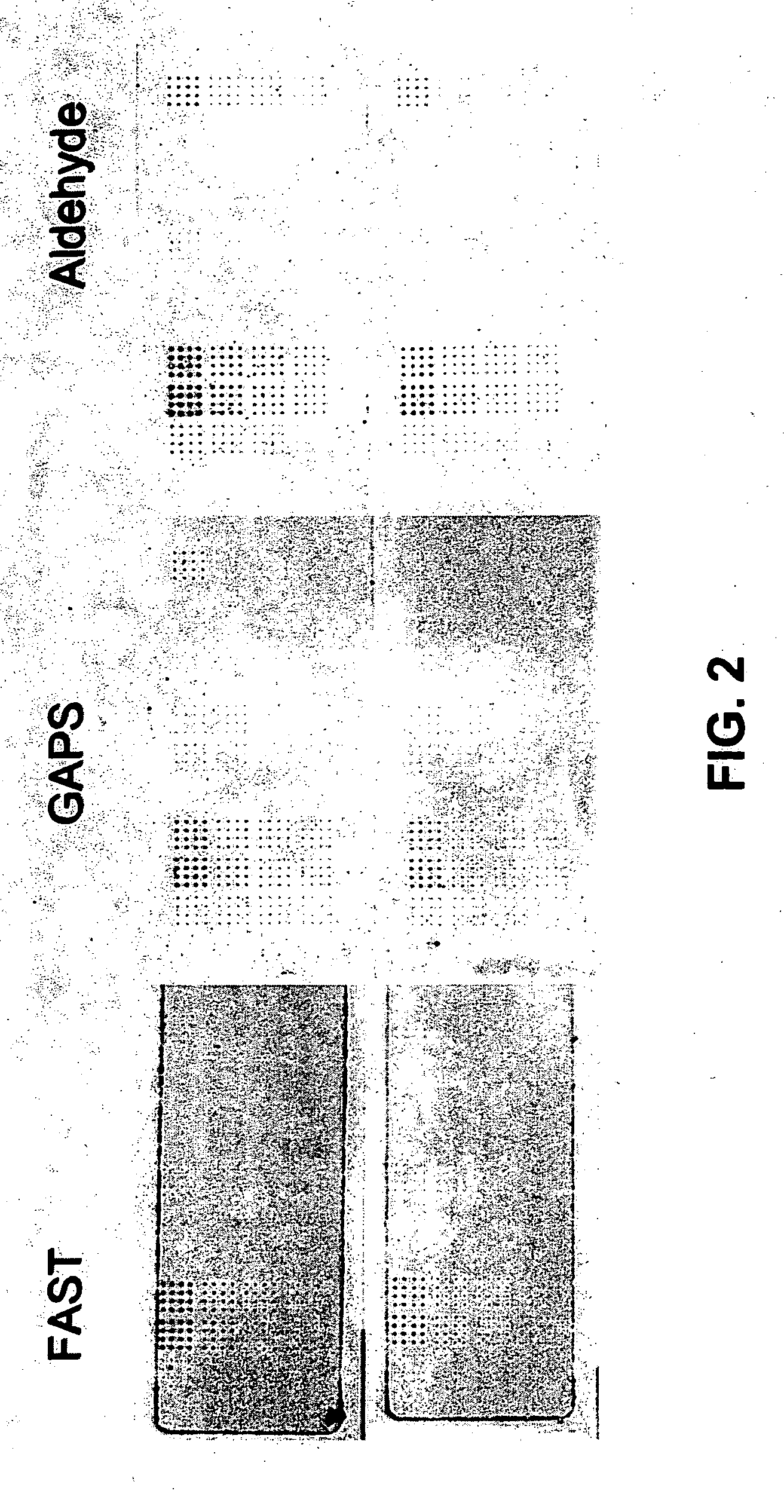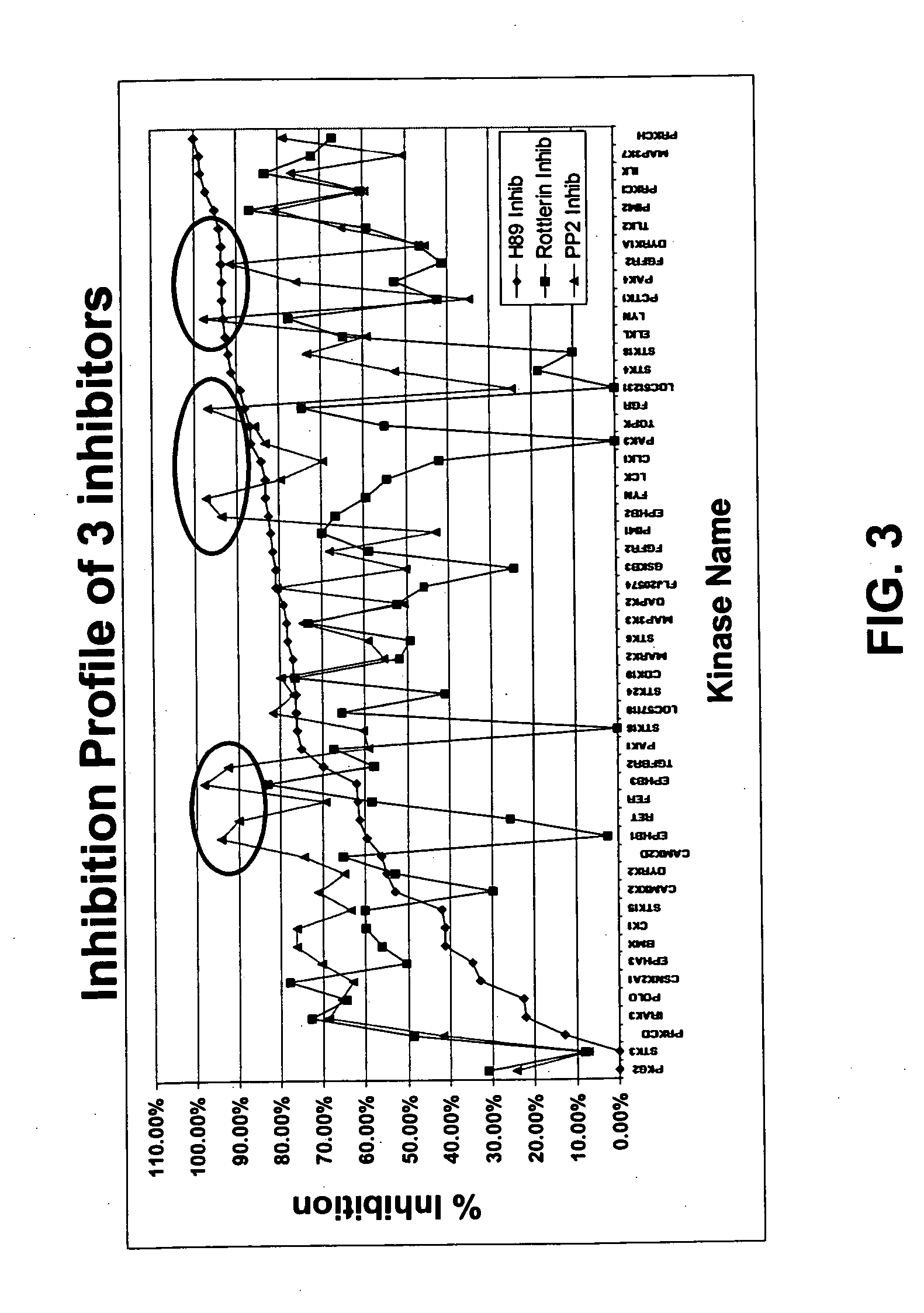Methods for conducting assays for enzyme activity on protein microarrays
a technology of enzyme activity and microarrays, applied in the direction of microbiological testing/measurement, biochemistry apparatus and processes, etc., can solve the problems of time-consuming process, insufficient correlation of transcriptional profiles with cellular protein levels or protein activities, and detailed analysis of individual protein biochemical properties
- Summary
- Abstract
- Description
- Claims
- Application Information
AI Technical Summary
Benefits of technology
Problems solved by technology
Method used
Image
Examples
example i
6.1. Example I
Kinase Activity Assay on Microarray
[0327] Materials & Reagents
Materials / Equipment / ReagentsVendorPart NumberDisposables / ReagentsGamma-AT33P (10 μCi / μl,Perkin ElmerNEG602H250UC250 μCi)Histone, Calf ThymusCalbiochem38205CaseinSigmaC-4032Myelin Basic ProteinSigmaM-1891Poly-glutamic acid-tyrosineSigmaP-2075PBS TabletsAmericanAB11108BioanalyticalTween-20AmericanAB02038Bioanalytical60 × 24 mm Hybridization CoverSchleicher &10 484 907slipsSchuellEquipmentCyclone Phospho-imagerPerkin ElmerB4312208 × 10 Autoradiography CassettesFisherFB-XC-810Phosphor Storage Screens (MS)Perkin Elmer7001723Lab RotatorLab-Line1314InstrumentsEppendorf Centrifuge (5810)Fisher Scientific05-400-60
[0328] Reagent / Stock Preparation
[0329] Kinase Substrate Stocks
[0330] Dissolve protein substrates in 20 mM Tris to a final concentration of 10 mg / mL.
[0331] 1 L of 1×PBS
[0332] Dissolve 5 PBS tablets in 1 L dH2O.
[0333] Mix thoroughly.
[0334] 1 L PBST
[0335] Dissolve 5 PBS tablets in 1 L dH2O.
[0336] Add...
example ii
6.2. Example II
Inhibitor Specificity Profiling
[0360] Fifty different kinases were immobilized on a slide together with a substrate as described in section 6.1. A mixture of Myelin Basic Protein (MBP), histone and casein was used as substrate. The kinase reactions were performed in the presence of H89 inhibitor, Rottlerin inhibitor or PP2 inhibitor (FIG. 3). The inhibitors were obtained from Calbiochem. The PP2 inhibitor is an inhibitor of tyrosine kinases. The concentration of inhibitor was 100 μm for each inhibitor. The control reaction was performed in the absence of inhibitor. The specificity of the assay was demonstrated by the fact that PP2 inhibitor strongly inhibited tyrosine kinases (see circled data points in FIG. 3).
example iii
6.3. Example III
Dose-Response Analyses
[0361] Microarrays were prepared with 10 wells / slide, wherein the kinases EPHB3, FYN, and PRKCD and their substrate were immobilized in each well. The slide was coated with substrate essentially as described in section 6.1. Subsequently, a gasket with 10 openings was applied to the surface of the slide thereby creating 10 wells, i.e., the gasket provides the barriers between the wells. The accession numbers for the different kinases in the NCBI database are: for FYN: NM—002037; for PRKCD: NM—006254; and for EPHB3: NM—004443. A mixture of Myelin Basic Protein (MBP), histone and casein was used as substrate. The kinase reaction was performed in each well with a different concentration of PP2 inhibitor.
[0362] The dose-response curve obtained is shown in FIG. 4a. The data show that PP2 strongly inhibits the tyrosine kinases FYN and EPHB3 but not the serine / threonine kinase PRKCD. In a second experiment, the kinase reaction was performed in each we...
PUM
 Login to View More
Login to View More Abstract
Description
Claims
Application Information
 Login to View More
Login to View More - R&D
- Intellectual Property
- Life Sciences
- Materials
- Tech Scout
- Unparalleled Data Quality
- Higher Quality Content
- 60% Fewer Hallucinations
Browse by: Latest US Patents, China's latest patents, Technical Efficacy Thesaurus, Application Domain, Technology Topic, Popular Technical Reports.
© 2025 PatSnap. All rights reserved.Legal|Privacy policy|Modern Slavery Act Transparency Statement|Sitemap|About US| Contact US: help@patsnap.com



